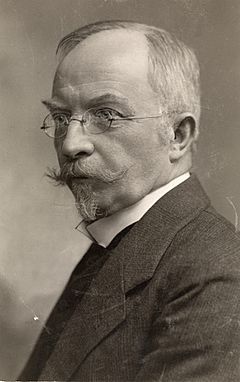Christian Sinding facts for kids
Quick facts for kids
Christian Sinding
|
|
|---|---|

Sinding c. 1930
|
|
| Born | 11 January 1856 Kongsberg, Norway
|
| Died | 3 December 1941 (aged 85) Oslo, Norway
|
| Occupation |
|
Christian August Sinding (born January 11, 1856 – died December 3, 1941) was a famous Norwegian composer. He is best known for his beautiful piano piece called Frühlingsrauschen, which means Rustle of Spring. This piece was written in 1896. Many people thought he was a successor to another great Norwegian composer, Edvard Grieg.
Contents
About Christian Sinding's Life
Christian Sinding was born in Kongsberg, Norway. His father was Matthias Wilhelm Sinding, who worked as a mine superintendent. His mother was Cecilie Marie Mejdell.
Christian had two brothers who were also artists. His brother Otto Sinding was a painter, and his brother Stephan Sinding was a sculptor. He also had a sister named Thora Cathrine Sinding.
In 1898, Christian Sinding married an actress named Augusta Gade.
Sinding's Musical Journey
Christian Sinding first studied music in Christiania (which is now called Oslo). After that, he moved to Germany to continue his studies. He attended the conservatory in Leipzig. There, he was taught by Salomon Jadassohn.
Sinding was greatly influenced by the music of famous composers like Richard Wagner and Liszt. He lived in Germany for most of his life. However, the Norwegian government gave him money regularly to support his work.
From 1921 to 1922, Sinding traveled to the United States of America. He taught composition for a year at the Eastman School of Music in Rochester, New York.
His Compositions
Christian Sinding's publishers often asked him to write music for piano and chamber groups. This type of music sold more widely than the big orchestral pieces he preferred. Sinding himself played the violin.
He wrote many short, beautiful piano pieces and songs. Because of this, many people saw him as a musical heir to Edvard Grieg. Sinding became well-known around the world as a Norwegian composer.
His most famous work is Frühlingsrauschen (Rustle of Spring), a piano piece from 1896. He also wrote four symphonies, three violin concertos, and one piano concerto. He composed chamber music, songs with Norwegian words, and an opera called Der Heilige Berg (The Holy Mountain), which premiered in 1914.
Awards and Honors
Christian Sinding received many important awards for his music.
- In 1905, he became a member of the Order of St. Olav. He was made a Commander in 1916 and received the Grand Cross in 1938.
- He was also appointed a Commander of the Order of Vasa.
- In 1905, he became a member of the Royal Swedish Academy of Music.
- In 1924, he was given the special honor of living for the rest of his life at Grotten in Oslo. This was the former home of the famous writer Henrik Wergeland.
Sinding's Later Years and Legacy
Towards the end of his life, Christian Sinding suffered from a serious illness that affected his memory. This began in the late 1930s.
Eight weeks before he passed away in 1941, Sinding joined a political party called Nasjonal Samling. However, his membership card was not signed. This party was connected to the Nazi occupation of Norway during World War II.
The Nazis wanted Sinding to join their party because he was very popular in both Norway and Germany before the war. After World War II ended, the national broadcasting system in Norway stopped playing music by people who were seen as supporters of the Nazis. Because of this, Sinding's music was not played as much in Norway after the war.
The reasons why Sinding joined the party are still debated today. He had spoken out against the Nazi occupation. He also helped Jewish musicians in the early 1930s and was a close friend of Nordahl Grieg, who was a strong opponent of the Nazis.
More About His Music
Images for kids
See also
 In Spanish: Christian Sinding para niños
In Spanish: Christian Sinding para niños



